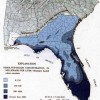 Pesticide applicators do not usually blame the mix for a pest control failure. Rather, the applicator will check if the correct pesticide was chosen for the job, if the pest was misidentified, if application equipment was properly calibrated, or if there was pesticide resistance. However, pesticide applicators should be aware that water quality can play a role in the efficacy of a pesticide treatment. Some pesticides lose their effectiveness when mixed with water that contains suspended or dissolved solids. This publication discusses how water quality affects pesticide mixes. This 2-page fact sheet was written by F. M. Fishel, and published by the UF Department of Agronomy, April 2013.
Pesticide applicators do not usually blame the mix for a pest control failure. Rather, the applicator will check if the correct pesticide was chosen for the job, if the pest was misidentified, if application equipment was properly calibrated, or if there was pesticide resistance. However, pesticide applicators should be aware that water quality can play a role in the efficacy of a pesticide treatment. Some pesticides lose their effectiveness when mixed with water that contains suspended or dissolved solids. This publication discusses how water quality affects pesticide mixes. This 2-page fact sheet was written by F. M. Fishel, and published by the UF Department of Agronomy, April 2013.
http://edis.ifas.ufl.edu/pi245
Tag: Pesticides and Water Quality
Applying Pesticides in Compliance with the National Pollutant Discharge Elimination System (NPDES) (PI239)
 On October 31, 2011, EPA issued a final National Pollutant Discharge Elimination System (NPDES) Pesticide Generic Permit for point source discharges from the application of pesticides to waters of the United States. This 10-page fact sheet explains what is now required for pesticide applications in Florida. Written by F.M. Fishel, and published by the UF Department of Agronomy, December 2011.
On October 31, 2011, EPA issued a final National Pollutant Discharge Elimination System (NPDES) Pesticide Generic Permit for point source discharges from the application of pesticides to waters of the United States. This 10-page fact sheet explains what is now required for pesticide applications in Florida. Written by F.M. Fishel, and published by the UF Department of Agronomy, December 2011.
http://edis.ifas.ufl.edu/pi239
PI1/PI001 Protecting Water Resources from Agricultural Pesticides
Revised! PI-1, a 5-page illustrated fact sheet by O. Norman Nesheim and Frederick M. Fishel, describes practices that help protect groundwater and surface water from pesticide contamination. Includes references. Published by the UF Department of Agronomy, April 2009.
http://edis.ifas.ufl.edu/PI001